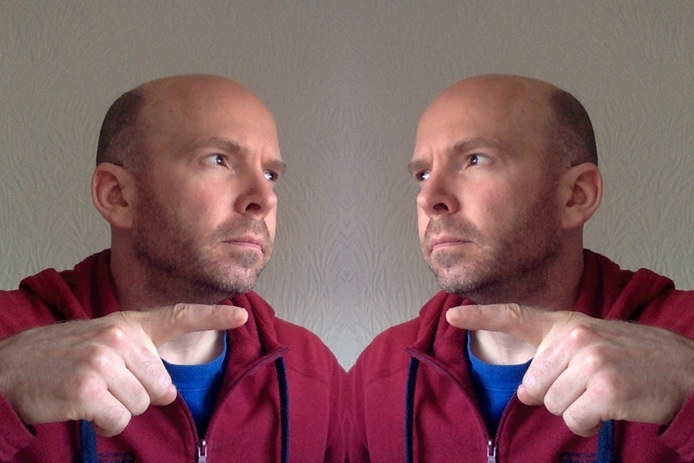---------------------------------------------------
The press had given him the nickname "worm man", but his friends knew him as Derek. Scientists had manipulated his DNA to mimic one of the most amazing features of the common or garden worm: the ability to regenerate lost tissue. And it had worked. When they chopped off his hand to test him out, a new one had regrown within a month.
Then it all went wrong. His body was slowly deteriorating. To save his life they had to transplant his brain into a new body. However, a major mistake during the operation severed his brain in two.
Fortunately, both halves fully regenerated and both were successfully transplanted into new bodies. The only problem was that both the men who now had one of the brains believed they were Derek. What is more, both had Derek's memories, mental skills, and personality. This created problems for Derek's boyfriend, who couldn't tell them apart. It also led to the Dereks getting entangled in a legal battle to claim Derek's assets. But which was the real Derek? They couldn't both be him, could they?
Source: Section 89 of Reasons and Persons by Derek Parfit, 1984.
Baggini, J., The Pig That Wants to Be Eaten, 2005, p. 136.
---------------------------------------------------
From the index to The Pig That Wants to Be Eaten, we can see that this is the third and final thought experiment based on the writings of Derek Parfit. I'm not sure why Baggini chose this repeat subject, rather than constructing something from Parfit's repugnant Repugnant Conclusion (I'll try to touch on that some other time), but let's deal with what is in front of us. In my Response to Experiment 30: Memories Are Made of This, I noted that:
This is now the second thought experiment inspired by Derek Parfit, who has been highly influential among contemporary philosophers on the subject of personal identity. Parfit is a reductionist, "believing that since there is no adequate criterion of personal identity, people do not exist apart from their components." In a late 1990's documentary on Channel 4 called Brainspotting, Parfit described four traditional theories of what components might constitute the self: the body, the brain, memories, or a soul. (You can see Parfit discuss this in two 10-minute clips here: Part 1, Part 2.) As an evolutionary philosopher looking at the evidence in nature, I've already dispatched with the idea of the soul. Descartes' dualism was thrown out long ago too, so we can rule out the body or the brain as separate entities that are able to work one without the other. And in the first Parfit-inspired thought experiment on the teletransporter, we saw that memories alone are also not able to necessarily and sufficiently explain personal identity. For example, what if the teletransporter made three of you that all remembered the same things? It's obvious that the three of you would diverge quickly into independent beings, but even before the divergence happened, there wouldn't only be one of you after the other physical copies had been made.
So the four traditional components of identity do not stand alone. (And the soul doesn't stand at all.) The brain, body, and memory are all integral parts of the whole, and they are not static entities. I first discussed the changing nature of such personal identity in my post on John Locke, whose theory of mind is often cited as the origin of modern conceptions of identity and the self. There, I gave another analogy for this topic that might prove helpful:
Identity lies at the Mind x Body intersection. One helpful analogy is to say identity is like a river. Not the water that flows through it, but the channel that actually forms the river. When storms occur and water is high, the river is deepened. When drought occurs, the river slows and silts up. When earthquakes or glaciers reshape the landscape, the riverbed may hold no water at all. If we know the events that carved the river, we can recognize its identity no matter what state it is in. Likewise, we can recognize identity when we know the events that shaped it. If you know the river and are told the volume of water that will flow its way, you know what the river will look like. If you know a person and are told the events that will occur to them, you will recognize how they handle it. This is how we know people after long absences, and this is how changes during brief separations can surprise us.
Such changes to identity were further explored in my Response to Thought Experiment 11: The Ship Theseus where I wrote:
So identity is not a fixed, unchanging thing. All people and things undergo metamorphoses over time. Sometimes slowly, sometimes cataclysmically. Words, labels, and categories may be easy to think of as permanent markers, but since the things they represent are always changing, then it follows that these names for things must be changing too. ... The universe and everything in it are always changing in almost infinitesimally continuous ways. We've developed the branch of mathematics called calculus to help describe these tiny changes, but it would be incredibly difficult to keep track of reality this way by calling everything x, then x1, then x2, then x3, etc. on into infinity. It's much easier for our brains and our languages to just call something X and treat this x as a concrete thing even though it actually has very fuzzy borders at the edges. ... I, for one, will try to remember this the next time I meet my friend called "Jane" or "Joe" or "Mary" or "Mike". They've changed since the last time I've seen them, and Jane724 might have something more to teach me than Jane723 did. And then I can become Edxxxx....."
Next, the rate of change of within these changing identities was explored in my Response to Thought Experiment 12: Picasso on the Beach, where I wrote:
The natures of things are always changing. This week, we see how that change can take place slowly, as in a Picasso painting, or quickly, as in a Picasso sand drawing. Of course, those speeds are relative too depending on the timeframe you choose to look at. Compared to cosmic time, even the painting that lasts a few hundred years, or several lifetimes to you and me, is around for just a tiny blink in existence. And while the sand drawing may last "half a lifetime" for a mayfly, we may find that it is gone too soon for our own tastes.
Finally, in my Response to Thought Experiment 38: I Am A Brain, we looked at a specific example of how identity can change by taking things away from an identity, piece by piece. For that scenario, I wrote:
There is a concept I failed to cover in my essay on David Hume that addresses this well, and that is Hume's idea of the bundle theory. (Bundle theory was discussed, though, in the silly Three Minute Philosophy video on Hume that I shared.) According to bundle theory, "an object consists of its properties and nothing more: thus neither can there be an object without properties nor can one even conceive of such an object; for example, bundle theory claims that thinking of an apple compels one also to think of its color, its shape, the fact that it is a kind of fruit, its cells, its taste, or at least one other of its properties. Thus, the theory asserts that the apple is no more than the collection of its properties." The clarity that bundle theory brings to this thought experiment comes when you imagine taking away all the properties of an object one by one until all of them are gone. Once that is done, according to Hume, nothing of the object is left. And so it is in this case, where our personal identity is a bundle of our purely physical body parts plus our mental parts that reside in our physical brains. Take them away one at a time, and "we" are still there in some capacity, but in a way that is understood to be diminished. In this case, Ceri 2 [brain only] < Ceri 1 [brain & body]. If the properties were taken away in a different order, say she suffered a stroke and her decimated brain was replaced with another working brain, then Ceri's body (Ceri 3) would still have life, but it would only be a very diminished sense of Ceri that was still around. In other words, Ceri 3 < Ceri 2 < Ceri 1. It is not until every property of her life has gone that we say Ceri has disappeared. But once all those bundled properties are removed, there is nothing left - no insubstantial, permanent soul.
All of this preparation leads us to a quick conclusion for this week's thought experiment, where an identity has changed by division and addition. In this case:
Derek Left ≠ Derek Right
Derek Left = Old Derek + New Derek Left
Derek Right = Old Derek + New Derek Right
We have as little trouble recognizing the new identities of these Derek's as we would for two identical twins whose shared portion of "old" would be purely genetic. The new Dereks would have shared portions of "old" that were made of genes AND experience, but their new experiences would quickly diverge them into separate and distinguishable identities. Unfortunately for the original Derek, his boyfriend and his possessions cannot split and regenerate, so they just have to be split in some negotiated way.
And with that, it's time for me to split too. Hopefully this old identity problem won't regenerate too many more times in the week's ahead.


